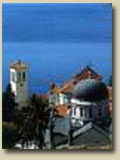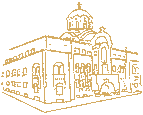| Information
Service of
the Serbian Orthodox Church
May
24, 2005

NEW ATTACKS ON SERBIAN CHURCH IN CROATIA
 Holy Father Nikolaj Church (1618) in Vrlica was broken into
during the night between May 21-22, 2005. Holy Father Nikolaj Church (1618) in Vrlica was broken into
during the night between May 21-22, 2005.
The church flag was also removed and burned. Police have conducted
an on-the-scene investigation but the unknown perpetrator still
has not been apprehended.
Provocations directed against priests have also become more
frequent as of late. Upon passing through Kistanje Father German,
the abbot of Krkva Monastery, and a group of seminarians traveling
with him by automobiles were exposed to insults. To make things
even worse, the insults came from people who illegally appropriated
monastery property. Orthodox Serbs in Dalmatia are uneasy due
to several incidents in the past few days but they hope that
the authorities will calm down those wishing well to neither
themselves nor others.

HAGIOGRAPHY OF ST. PETER OF CETINJE BY METROPOLITAN MITROFAN
BAN DISCOVERED IN OSTROG MONASTERY  A previously unknown document about St. Peter of Cetinje whose
author is the Metropolitan of Montenegro and the Littoral Mitrofan
Ban was recently discovered in the archives of Ostrog Monastery.
The discovery was made by Professor Predrag Vukic, a historian
in the employ of the State Archives. A previously unknown document about St. Peter of Cetinje whose
author is the Metropolitan of Montenegro and the Littoral Mitrofan
Ban was recently discovered in the archives of Ostrog Monastery.
The discovery was made by Professor Predrag Vukic, a historian
in the employ of the State Archives.
According to the Professor, the manuscript by Metropolitan Mitrofan
Ban bears the title “Hagiography of St. Peter of Cetinje” and
consists of 26 handwritten pages describing the life of St. Peter,
according to both folkloric sources as well as historical facts.
“The document also bears the signature of Mitrofan Ban, which
clearly and unambiguously confirms that he is the author. In
addition to already known facts, the hagiography also includes
folkloric teachings related in a short and approachable form,
which basically confirm the supernatural powers of St. Peter
of Cetinje. This refers to his curses and blessings, which have
been recorded by Mitrofan Ban. Of course, this is just a fragment
in comparison with the rich folkloric teachings about St. Peter
and his unique spiritual powers,” said Professor Vukic. He added
that to this day these teachings have not been collected in a
single work. In conversation with Radio Svetigora he said that
the document was found in a file containing later documents relating
to the period of the Kingdom of Yugoslavia.
Vukic said that with the blessing of Bishop Joan, the abbot
of Ostrog Monastery, he will try to see the document published
in the near future and thus inform the general public of its
contents.
Source: Svetigora

FORMAL OPENING OF THIS YEAR’S STS. CYRIL AND METHODIUS SYMPOSIUM
IN HERCEG NOVI  The eleventh annual theological and philosophical symposium,
which is this year is dedicated to the theme of “Memory and Forgetting”
began yesterday in Savina Monastery in Herceg Novi. The eleventh annual theological and philosophical symposium,
which is this year is dedicated to the theme of “Memory and Forgetting”
began yesterday in Savina Monastery in Herceg Novi.
"Forgetting
is the root of all sin. Humanity is transient like the dust
and if it is bound to the truth, all memory is
connected with the name of God. What else is in a name but memory
for it is by name that human works are protected,” said His Eminence
Metropolitan Amfilohije of Montenegro and the Littoral yesterday,
as he opened the eleventh annual theological and philosophical
symposium in Savina Monastery yesterday dedicated to the theme
of “Memory and Forgetting”.
The first speaker at this theological and philosophical gathering
organized by the Metropolitanate of Montenegro and the Littoral
and the Faculty of Philosophy in Niksic was His Eminence Metropolitan
Kyrill of Varna and Veliki Preslav. He compared the Slavic illuminators
Cyril and Methodius and their contribution to the Slavs with
a special overview with the years 1876, which was fateful for
Bulgaria, and 1875, when the Herzegovina uprising occurred in
which Montenegro also took part.
American literary historian at Podgorica University Radojka
Vukcevic spoke about memory and forgetting through the prism
of the novel “A Possible Life” by Stoja Magdalinic. Magdalinic’s
novel is set in 1942 in the village of Basca near Rozaj with
events spreading to Yugoslavia, Albania and Italy during the
tempest of World War II.
“Magdalinic creates a bridge between history and fictional narrative,
and demonstrates a unique self-consciousness with respect to
the narrative and textual nature of the past. Historical and
biblical remembrances, mythological recapitulations, reminisces,
anthropological and psychological generalizations and not infrequent
deep philosophical mediations are interwoven naturally and spontaneously,”
said Vukcevic of “A Possible Life”.
Vladimir Djordjevic from Smederevska Palanka spoke about “Forgetting
and Anamnesis” regarding truth, forgetting and remembering, philosophy
and technology.
The presentation of Professor Vuko Velas from Herceg Novi dealt
with “Vertical Memory, the World of Life and Culture”, and Visnja
Kosovic spoke about temporal collectivity as the essence of meaning.
Source: Svetigora

INVITATION TO PRESS AND MEDIA CONFERENCE On Wednesday, May 25, 2005 at 1:00 p.m. a press and media conference
and presentation of three-dimensional laser scanning of Chilandar
Monastery will be held in the conference room of the Serbian
Ministry of Culture, Vlajkoviceva Street no. 3.
The results of scanning conducted at Chilandar Monastery will
be presented at the conference.
The Serbian Institute for the Protection of Cultural Monuments
contracted the VEKOM company to carry out three-dimensional scanning
of Chilandar Monastery.
Three-dimensional animation and the results of scanning of this
unique cultural monument will be shown to reporters and experts
in the field.
In addition to representatives and experts from VEKOM company,
the meeting will also be attended by Minister Dragan Kojadinovic,
Deputy Minister for the Protection of Cultural Heritage Miladin
Lukic, and the director of the Serbian Institute for the Protection
of Cultural Monuments, Gordana Markovic.

[Serbian
Translation Services]

Copyright © 1999-2004 by
The Information Service of the Serbian Orthodox Church
11000 Belgrade
Kralja Petra I no.5
+381 11 3282 596
e-mail
|

